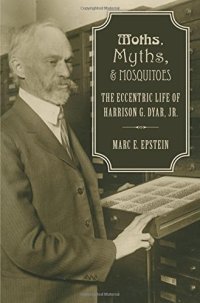Machine generated contents note: -- PART I: PREPARATORY STAGES -- Ch. 1: The Dyars and the Hannums: An Earlier Generation -- Ch. 2: Dyar, Jr: Early Growth Stages and Development -- Ch. 3: Collecting and Rearing Lepidoptera, and Dyar's Law: 1882-1891 -- Ch. 4: Long Collecting Trips and Sawflies: 1889-1897 -- Ch. 5: Postgraduate Education: Classification of Moths and Bacteria -- Ch. 6: Genealogy of the Limacodidae and
the Dyars -- Ch. 7: Last Days in New York, L.O. Howard, and a Move to the U.S. National Museum -- PART II: BEGINNING A NEW LIFE AT THE USNM AND IN WASHINGTON -- Ch. 8: Life in the District of Columbia and Wellesca Pollock -- Ch. 9: Building the National Collection, Dyar's "List of Lepidoptera," and the Entomological Society of Washington -- Ch. 10: Battle of the Titans Smith and Dyar, and Their New Love - The "Skeets"--Ch. 11: Collecting Moths, Mosquitoes, and Travels: 1901-1909 -- Ch. 12: Literature Wars and Last Battles with Smith -- Ch. 13: Advances and Conflicts in Professional Life as a Lepidopterist: 1907-1914 -- PART III: MRS. ALLEN, DIVORCES, AND THE AFTERMATH OF THE -- SCANDAL -- Ch. 14: Wellesca's Baha'i Faith, New Wealth and Growing Concerns by Zella as Dyar's Life Begins to Unravel: 1906-1908 -- Ch. 15: Marriage Troubles -- Ch. 16: The Separation: 1915 -- Ch. 17: Divorce Wranglings in Reno -- Ch. 18: Divorces, Appeals, and Bigamy -- Ch. 19: After the Scandal, Dismissal, and Friend Knab: 1917-1918 -- PART IV: THE FINAL DECADE: ATTEMPTS AT REINSTATEMENT -- Ch. 20: The National Collection of Lepidoptera, its Workers, and Their Tiffs: 1920s -- Ch. 21: Mosquitoes and Pursuit of Reinstatement -- Ch. 22: Dyar and His Tunnels -- Ch. 23: Personal Life and Baha'is in the 1920s -- Ch. 24: Unity in the UNSM Lepidoptera Section and Acquiring the Barnes Collection -- Ch. 25: Final Days: Trip West, Projects, and as Custodian -- Ch. 26: Financial Collapse and Final Push for Reinstatement -- Epilogue"On September 26, 1924, the ground collapsed beneath a truck in a back alley in Washington, D.C., revealing a mysterious underground labyrinth. In spite of wild speculations, the tunnel was not the work of German spies, but rather an aging, eccentric Smithsonian scientist named Harrison Gray Dyar, Jr. While Dyar's covert tunneling habits may seem far-fetched, they were merely one of many oddities in Dyar's unbelievable life. For the first time, insect biosystemist Marc E. Epstein presents a complete account of Dyar's life story. Dyar, one of the most influential biologists of the twentieth century, focused his entomological career on building natural classifications of various groups of insects. His revolutionary approach to taxonomy, which examined both larval and adult stages of insects, brought about major changes in the scientific community's understanding of natural relationships and insect systematics. He was also the father of what came to be known as Dyar's Law, a pragmatic method to standardize information on insect larval stages as they grow. Over the course of his illustrious career at the U.S. National Museum, Smithsonian Institution from 1897-1929, Dyar named over 3,000 species, established the "List of North American Lepidoptera," an unrivaled catalog of moths and butterflies, and built one of the nation's premier lepidoptera and mosquito collections. However, Dyar's scientific accomplishments are a mere component of this remarkable biography. Epstein offers an account of Dyar's complicated personal life, from his feuds with fellow entomologists to the scandalous revelation that he was married to two wives at the same time. Epstein also chronicles Dyar's exploration of the Baha'i faith, his extensive travels, his innumerable works of unpublished fiction, and the loss of his wealth from bad investments. Comprehensive and engaging, Moths, Myths, and Mosquitoes will delight entomologists and historians alike, as well as anyone interested in exploring the zany life of one of America's virtually unknown scientific geniuses"
"Known for years by Washington, D.C. history buffs and entomologists as an eccentric's eccentric for his underground tunnels, bigamy, and fighting with colleagues, it is oft forgotten that Harrison Gray Dyar, Jr. was a world-class scientist from 1890s until his death. His contributions to the understanding of evolution, classification, and the biology of moths, mosquitoes and primitive wasps have stood the test of time, as have his underappreciated contributions to building the national collections of these insects at the Smithsonian Institution"

